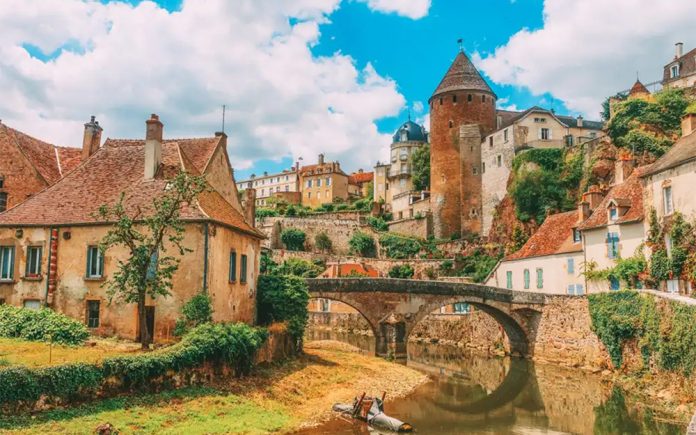
By Rick Riozza
Allors! Well then—last week, we did our annual La Tour de France coverage, whose course traveled from Copenhagen to the north and east of France. Our wine example for the scenic region traveled was a highly-rated and expensive red Burgundy wine that reflected the great collector vintage of 2019.
Now that we are in the last exciting stages of the bicycle race, we’ll see the racers swing through the south of France, climb the Pyrenees Mountains, and then off to the finishing line on Avenue des Champs-Élysées in Paris. With over 180 million viewers around the world watching La Tour de France live, it matches the International Soccer World Cup and the Olympics as to the most observed sporting event. And to boot!—the back-drop of the three week event is the beautiful country of France.
So—as the riders are currently in the surrounding wine regions, let’s cover some of those French wines you’ve heard of, but may not really know what they are.
And quick to the chase, the region and wines that we’re referring to are Minervois, Corbières, and Limoux. Yep—you’ve seen these names on bottles at your favorite wine shop, but perhaps you were a bit reluctant to try one.
Minervois [Meen-ur-Vwah}, the name comes from the scenic village of Minerve, a historical place in the Languedoc region. It is just north of Corbières [Core-bee-erre]. There is no broad plain here, just a narrow alluvial corridor between the Corbières mountains and the Minervois terraces through which are funneled the River Aude, the Canal du Midi, and the road and rail links between the Mediterranean and Atlantic that have superseded this 17th-century miracle of engineering.
For you Southern Rhone fans, you already know the red grapes of the above region: Carignan, Cinsault, Grenache, Mourvèdre, and Syrah.
The Roman legionnaires planted the first vines and soon the wine was already famous: Cicero and Pline were among Minervois lovers.
The Minervois AOC produces mainly red wines. These wines with good aging potential are defined as soft and velvety, with silky tannins and ripe fruit aromas. As you’d expect with the region’s grapes, the wine is full-bodied.
One of our favorite wines at a great price for the quality and great flavor profile is the 2019 Château Maris Cru La Livinière Les Planels Minervois ($19). We agree completely with the winery notes: “The aromas include thyme, rosemary, some menthol notes, and a touch of lavender. This aromatic bouquet propels you into the heart of the vine. In the mouth, this sunny wine communicates over the full length of the tongue: a bouquet of already complex aromas with some notes of sautéed black cherries, blackcurrant, licorice, pepper and red meat with dark purple color; Rich, full-bodied, yet elegant and seamless, with an impressive texture. An integrated acidity and a beautiful elegance, making you come back to the glass. Aging potential: 7-10 years.”
Corbières red, on the other hand, generally tastes a bit more “wilder/rustic” than its neighbor to the north. It’s an exciting and sexy red wine for those who like to smell & taste the “garrique” of the South of France. 2018 Domaine des Deux Cles ‘Cles En Main’ Rouge 2018 ($26). The Kingston Wine Company wrote of this wine as “a full-bodied yet exceedingly elegant red made of primarily old vine Carignan, with 10% of the wine coming from 40-year-old plantings of Syrah. All farmed biodynamically in plots of clay and limestone soils. Fermented naturally and aged in concrete and steel tanks, half as whole clusters. Dynamic deeply blue fruit notes with Mediterrean herbs and a stoney mineral structure.”
Limoux [Lee-moo] is best known for its sparkling wine. It’s reputed to be the oldest sparkling wine region in France and dates back to 1531 when Benedictine monks from Saint Hilaire Abbey discovered that the wine they had laid down had fermented and formed bubbles. There is always the debate with the fans of, well, you-know-whom: Dom Pérignon over in Champagne country.
The Crémant de Limoux is very popular these days, especially around the holidays, because you have Champagne-like quality for a $20 bottle of bubbly. The Crémant is usually made up of predominately Chardonnay with a good dose of Chenin Blanc. Pinot Noir shows up here and there.
It utilizes traditional (champenoise) method and is a sparkler geared towards the modern, internationally styled bubbly. In Languedoc, this style reaps great results on the gentle, but very windy slopes surrounding the town of Limoux, southwest of the UNESCO World Heritage fortified city of Carcassonne.
We wrote of an excellent Crémant de Limoux a couple of Christmas’ ago: Faire La Fête ($20) Golden in color with vibrant aromas and flavors of baked apple, white cherry and lemon meringue with a prominent yet delicate mouth-feel. A perfect sparkler to toast the winner of La Tour de France. Cheers!











































